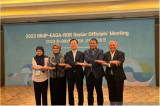Southeast Asia’s economic outlook brightening: Nikkei Asia
Southeast Asia's economic prospects continue to stand out in a world faced with high inflation and soft demand, according to Nikkei Asia.
An article published by the Tokyo-based newspaper on July 25 cited HSBC as forecasting that the six largest economies in Southeast Asia – Indonesia, Thailand, Malaysia, the Philippines, Singapore, and Vietnam – will grow 4.2% this year and 4.8% next year. This pace would far outstrip the 1.1% expansion expected in the developed world in 2023 or next year's estimated 0.7%.
This acceleration is all the more remarkable given that inflows of Chinese tourism money have not returned to Southeast Asia as anticipated.
A recovery in tourism would certainly be a welcome boon for Southeast Asia. But meanwhile, trade, the transition to net zero, and digital transformation are set to power the region's economic growth for decades to come and ensure that this dynamic region remains a global growth engine.
The writing noted that Southeast Asia has come a long way as a manufacturing dynamo. It now accounts for 8% of the global exports and, since 2020, has surpassed the European Union as China's largest trading partner.
The region is benefiting from a restructuring of global supply chains as it sits at the crossroads of two of the world's largest free trade agreements, the Regional Comprehensive Economic Partnership (RCEP) and the Comprehensive and Progressive Agreement for Trans-Pacific Partnership (CPTPP).
According to a recent HSBC survey, Asia-Pacific companies plan to base 24.4% of their supply chains in Southeast Asia over the next one to two years, up from 21.4% as of 2020.
As more companies diversify and adopt a "China+1" production strategy, Southeast Asia will continue to gain market share. More global foreign direct investment will be directed toward the region as the centre of gravity of global manufacturing continues to shift.
The transition to net zero is a second structural trend that is bringing tremendous opportunities as Southeast Asia races to "green its grid", the article noted.
Most of the energy powering Southeast Asia comes from fossil fuels, so it is encouraging that Indonesia and Vietnam – two of the region's most dynamic economies as well as two of the world's top coal-burning countries – have each announced Just Energy Transition Partnerships with the Group of Seven and other developed nations.
Under this new funding model, tens of billions of dollars in public and private finance will be mobilised, catalysing the decarbonisation of the two countries' power sectors and facilitating their clean energy transition.
The third long-term source of optimism about Southeast Asia is the digital transformation of the region's economy.
Southeast Asia already has a vibrant digital economy, which was worth nearly 200 billion USD as of last year and is expected to surpass 300 billion USD in size by 2025. Add in an internet-connected population of 460 million, and it is evident why companies are transforming their business models to cater to changing customer behaviour.
As an economic engine with favourable demographics, Southeast Asia is well positioned to capture the opportunities stemming from these long-term trends, the article read./.
VNA
 Bulgaria charts new course with Vietnam on President’s upcoming visit: Diplomat
Bulgaria charts new course with Vietnam on President’s upcoming visit: Diplomat
 Seminar seeks ways to boost ASEAN - Latin America connectivity
Seminar seeks ways to boost ASEAN - Latin America connectivity
 Indonesia seeks India's help in health education
Indonesia seeks India's help in health education
 Indonesia named world's most generous country in 2024
Indonesia named world's most generous country in 2024
 Philippines: Over-4m-high floodwaters make thousands of houses submerged
Philippines: Over-4m-high floodwaters make thousands of houses submerged
 Singapore’s public sector records carbon reduction in 2023
Singapore’s public sector records carbon reduction in 2023
 Pressure facing the EU on its growth track
Pressure facing the EU on its growth track
 Efforts boosted to combat transnational organised crime
Efforts boosted to combat transnational organised crime
 Nearly 200 terror suspects arrested in Indonesia in two years
Nearly 200 terror suspects arrested in Indonesia in two years
 Vietravel launches tourism joint venture in India
Vietravel launches tourism joint venture in India



